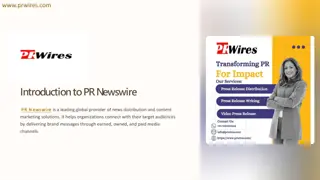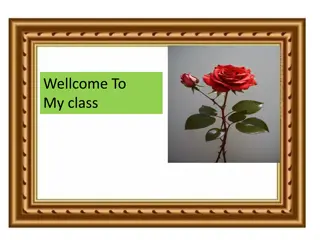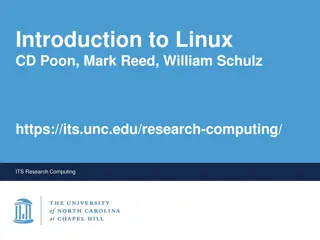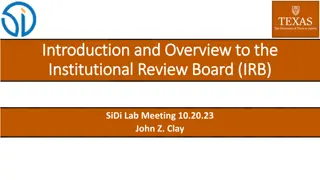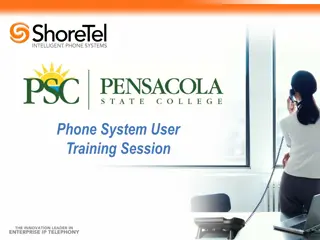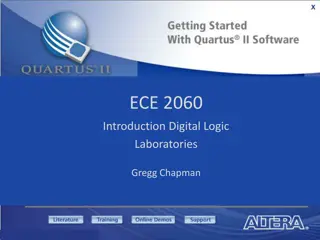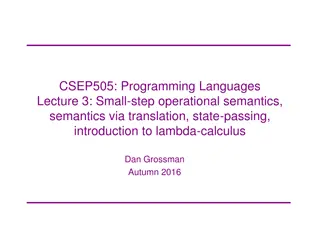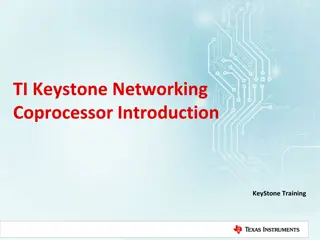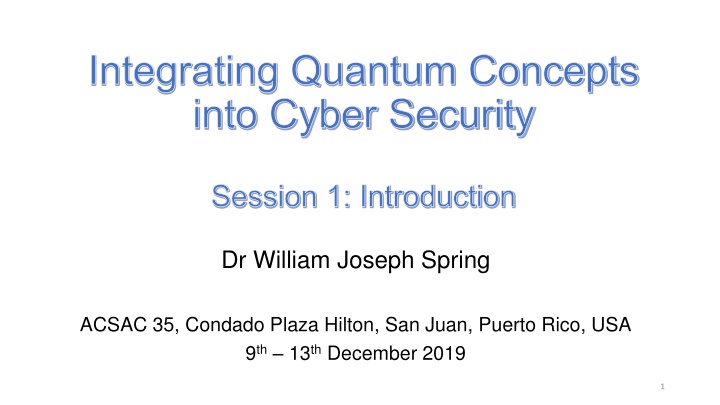
Integrating Quantum Concepts into Cyber Security: A Workshop Overview
Explore the integration of quantum concepts into cyber security at the ACSAC 35 session with Dr. William Joseph Spring. Delve into the potential of quantum-based networks, algorithms, attack vectors, defense mechanisms, and more. Gain insights into the development of secure systems for classical and quantum-based networks, discussing concepts like qubits, superposition, entanglement, and more. Discover the advancements in quantum distributed systems and networks, comparing classical and quantum communication systems for secure applications. Engage in hands-on activities to enhance your understanding of working with quantum systems.
Download Presentation

Please find below an Image/Link to download the presentation.
The content on the website is provided AS IS for your information and personal use only. It may not be sold, licensed, or shared on other websites without obtaining consent from the author. If you encounter any issues during the download, it is possible that the publisher has removed the file from their server.
You are allowed to download the files provided on this website for personal or commercial use, subject to the condition that they are used lawfully. All files are the property of their respective owners.
The content on the website is provided AS IS for your information and personal use only. It may not be sold, licensed, or shared on other websites without obtaining consent from the author.
E N D
Presentation Transcript
Integrating Quantum Concepts into Cyber Security Session 1: Introduction Dr William Joseph Spring ACSAC 35, Condado Plaza Hilton, San Juan, Puerto Rico, USA 9th 13thDecember 2019 1
Introduction This set of presentations will include Introduction and Overview Classical and Quantum Networks Algorithms A selection of Attack vectors and their Defence 2
Introduction The potential for realizing quantum-based networks and distributed systems has now been realized through reports of networks in excess of 2000km and commercial quantum based private communication networks reported as complete. Quantum based cloud services are now under development on a commercial basis and a quantum-based internet is proposed for the future. Associated with these and other developments in for example: types of computer programming paradigms operating systems event ordering issues emerge as new quantum concepts are integrated into the cybersecurity landscape.
Introduction In this workshop, aimed primarily at researchers new to quantum concepts, we consider a range of underlying concepts employed in the development of secure systems for both classical and quantum-based networks and distributed systems. From a quantum perspective we will discuss different types of qubit, qudits, superposition discrete and continuous states mixed states multipartite states entanglement, gates measurement and their incorporation into the cybersecurity environment.
Introduction Research in quantum distributed systems and networks is now said to be in its second wave developing the potential for applications in, for example satellite communication quantum-based resources secure communication We compare and contrast classical and quantum communication systems with a view to: identifying similarities and differences that exist between the two to present a selection of advantages and disadvantages in employing such paradigms to consider a selection of vulnerabilities from each, within for example an attacker defender perspective. From a hands on perspective, we seek to present a selection of activities that participants can engage in, in order to develop and extend their understanding in working with quantum systems.
Cyber Security Assets Motivation Attackers and Vulnerabilities
Cyber security the protection of information systems from theft or damage to the hardware, the software, and to the information on them, as well as from disruption or misdirection of the services they provide M. Gasser, 1988, Building a secure computer system, van Nostrand Reinhold. Information security the practice of preventing unauthorized access, use, disclosure, disruption, modification, inspection, recording or destruction of information
Assets Hardware Servers Switches Sensors Software Mission critical applications Support systems Confidential data Genome data Medical records Assets need to be protected if replacement is expensive or if the asset is important to the owner. Sensors, for example, may be inexpensive but in mission critical systems damage due to not protecting them may be very costly
Motivation Motivating factors for using such assets include Sharing of resources Reduction in cost Increase in computational processing Reliability With threat modelling for such systems we seek to establish: What data do we need/want to protect Where are the information flows What functions are engaged in the processing of data through the employment of services Cloud services conveyance of packets What systems do I have to rely upon Assets should be protected from unwanted access, use, disclosure, alteration, destruction and/or theft resulting in loss to the organisation be it actual or in terms of reputation Wiki
Attackers and Vulnerabilities Attacks can take various forms: Denial of Service Malware Phishing Session hijack Man in the middle Insider attacks Are these applicable to quantum networks?
Cyber security Naturally following from the previous statements we meet the following concepts: Authentication Establishing for example that I am who I say that I am and that I am entitled to gain access to some entity such as my computer Confidentiality Any data sent between two parties is not seen by unauthorised observers Integrity Establishing that the message sent is the same as the message received Non repudiation Ensuring that the sender of some information cannot deny that they sent the information Accessibility If I am entitled for example to use a service then I want to be able to do so Anonymity In for example voting schemes where one might also like confidentiality One tool that is often quite useful is cryptography
Protection Central to the protection of for example networks we have a need for: Physical Security For example if I have a communication system reliant upon satellites being in certain positions and or uncompromised I have to ensure that these requirements are met or quickly reinstated Trust I have to trust those that can access my systems generally in a covert way, for example who is updating my computer system Cryptography A long standing tool in maintaining a degree of control and defence of information systems Protocols The way in which we process data matters
Quantum Processing Quantum processing promises the possibility for obtaining solutions to a range of difficult problems. From a security perspective this involves the possibility for Breaking Asymmetric Key Algorithms via Shor s Algorithm The RSA algorithm based on the IFP (Integer Factorisation Problem) The El Gamal algorithms based on the DLP (Discrete Logarithm Problem) Obtaining secure communication channels for free Authentication, confidentiality, integrity, Employing quantum based encryption schemes Detecting eavesdroppers on a channel Detecting intruders in a system Developing new applications in a range of different fields 14
Quantum Tools The tools employed include and are not limited to Superposition Entanglement Error Correction Entanglement Swapping Teleportation Flying and Stationary Qubits Parallelism Interference 15
Classical & Quantum Representations Quantum Quantum bits are used, referred to as qubits, which may be organised into manageable chunks via tensor products Information may be encoded using a superposition of quantum bits, (qubits) and organised via the use of tensor products Information is processed using gates and communication channels Classical Bits, nibbles, bytes, . 0 s and 1 s aka cbits 4 bits and 8 bits, Communication of information is achieved via binary bits (cbits) which are grouped into manageable chunks Information is processed using gates and communication channels 17
Classical & Quantum Representations Quantum Quantum bits (qubits) are vectors they have magnitude and direction, magnitude = 1 qubits have 2 degrees of freedom (think of as movement in the x direction and movement in the y direction Examples of gates: Matrices Pauli gates, Hadamard gate, CNOT gate, Phase gate, Classical Bits, nibbles, bytes, . Classical bits (cbits) are scalars Examples of gates: logic gates NOT AND OR NOR NAND XOR 18
Quantum States 1 Standard cbits are represented as vectors in a Hilbert Space: 1 0 0 1 = = 0 and 1 referred to as the basis Z 0 + 1 1 1 1 1 + = = and referred to as the basis X 1 2 2 19
Quantum States Superposition + { , } { 0 , 1 } From the Z basis (or the X basis superposition of their basis vectors ) qubits are formed as a = + + = 2 2 0 1 = with | | | | 1 and , or similarly we can express qubits in the X basis + ' ' ' ' 1 = + + + = 2 2 ' ' = (in terms of the Z basis) with | '| | '| 1 2 ', ' and 20
Postulate 1 State Space Associated to any isolated physical system is a complex Hilbert Space (a complex vector space with inner product) known as the state space of the system. The system is completely described by its state vector, which is a unit vector in the systems state space Nielsen and Chuang, Quantum Computation and Quantum Information, CUP, 2000/2010 21 Lecture - Quantum Postulates
Quantum States Superposition Qubits also have operator representations called density operators 2 | | = = = 2 | | z and Bloch Sphere representations in 3d space Pure states map to the surface Mixed states map to the interior of the Bloch Sphere Mixed states are Hyperbolic space objects 0 = = with pure states i i i i i y + x 1 Ungar, A. (2002) The Hyperbolic Geometric Structure of the Density Matrix for Mixed State Qubits. Found. of Phys. 32, 11 22
Pure States and Mixed States Given an ensemble of quantum states we may obtain an overall quantum state n p = = in which each is a pure state i i i 1 i 2 A state is said to be pure if and only if the trace of is 1 and mixed if the trace of lies strictly between 0 and 1 2 ( ) 1 for a pure state 0 < ( ) 1 for a mixed state tr 2 = tr 2 ( ) 1 tr = Note that the trace of a quantum state is 1:
Postulate 4 Composite Systems The state space of a composite physical system is the tensor product of the state spaces of the component physical systems. Moreover if we have systems numbered 1 through | n, and system number i is prepared in the state , then the i joint state of the total system is n = = 1| | | ... ... ... | 1 2 i n i Nielsen and Chuang, Quantum Computation and Quantum Information, CUP, 2000/2010 24
Quantum States For multipartite states we use tensor products to obtain vectors of the form = = = ... ... ... 1 2 3 1 2 3 1 2 3 n n n With corresponding density operators = = ... ... 1 2 3 1 2 3 n n In which = denotes a qubit and i i i i This leads us to the concept of entanglement, a major resource in QIP (Quantum Information Processing) 25
Entanglement Two fundamental views Algebraically no common vector factors, irreducible, prime states Correlation View Entangled photons are seen to be correlated or anti- correlated (both spin up or both spin down as opposed to one spin up and the other spin down) 1( 00 2 = + Examples: 11 ) 00 Bell states, GHZ states, W states Partial entanglement for subsystems of a general system also used 26
Entanglement From an algebraic perspective entangled states and primes share a common property in that their status is dependent upon the space in which they are perceived to belong. For example = + + 17 (4 1 is irreducible over [x] but not over [x] )(4 ) is prime over but not over ( ) i i i 2 x 27
Entanglement Local and Global Operators Likewise Bell states for example , are said to be entangled provided that they are restricted to the local action of operators from ( qubit space, however if we extend the operator space to B( Bell states are said to be separable. It is the potential for access to global operators that characterises a state as either entangled or separable ( ) ) ( B H H ) then the H ), a B H H 28
Gates 29
The Action of a Matrix on a vector Matrices: A 2x2 matrix, (2 rows and 2 columns Example: Let and , then the action of A on is defined to be: a b x ax by A c d y cx x y a c b d = = A + + = = (definition) dy 30
Quantum Gates In order to describe the development and change of a state we employ gates/operators. Central to our discussions will be the Pauli Gates 1 0 0 1 = = = = = = = = = = = I 0 0 1 1 0 X 1 X 0 i i = with 1 Y i 2 Y 0 1 0 0 Z 3 Z 1 31
Quantum Gates The CNOT Gate (controlled NOT gate) 1 0 0 0 0 1 0 0 0 0 0 1 0 0 1 0 = = + + + 0 0 1 1 2 3 3 2 CNOT Dirac Notation a b a b 0 0 1 1 0 1 0 1 0 1 1 0 a a Control b a b Target 32
Quantum Gates The Hadamard Gate 1 1 1 1 = H 1 2 1 1 1 1 H H Note: + = = + 0 ( 0 1 ) 0 2 2 1 1 1 H H = = 1 ( 0 1 ) 1 and 1 2 2 33
Quantum Gates The Phase Gate 1 0 0 i = = + 0 0 1 1 P e i e In which 0 0 ie 1 1 Each of the above gates are examples of unitary gates They are reversible, unlike many of the classical gates 34
Quantum Gates The Projection Gate / Operator Let denote a projection operator P = = = T 2 Then in which P P P P P Examples 1 0 0 0 0 0 0 1 = = = = , 0 0 , 1 1 , , I P P P P + 0 1 Projection gates are in general not reversible They are in general examples of Hermitian / Self Adjoint Operators 35
Postulate 2 - Nielsen and Chuang Evolution The evolution of a closed system is described by a unitary | transformation. That is, the state of the system at time | t1 is related to the state of the system at time t2 by a unitary operator U which depends only on the times t1 and | U = t2 , | Nielsen and Chuang, Quantum Computation and Quantum Information, CUP, 2000/2010 36
Quantum Properties Some Useful Properties that we have to work with: No Cloning The No Cloning Theorem states that it is impossible to copy general quantum states, with a Unitary copier. For non orthogonal pure states, copying is impossible, without a loss in fidelity for any copier Measurement (in general) leads to change So if you try to measure a quantum state you will in general change the state see measurement postulate below These properties have been employed in, for example, quantum key agreement protocols such as: BB84, B92, E91, 38
Quantum Supremacy Quantum Supremacy 2018 Google 49 qubits, IBM 51, ? 53 qubit 2019 Google claim quantum supremacy, using 54-qubit Sycamore processor Performs calculation in 200 seconds rather than 10,000 years by the most powerful supercomputer IBM challenge the fidelity of the work, claiming Google failed to fully account for plentiful disk storage The calculation involved generating random numbers Quantum Supremacy using a programmable superconducting processor, Nature, vol574,24th October 2019, https://doi.org/10.1038/s41586-019-1666-5 39
Quantum Tools The tools employed include and are not limited to Superposition Entanglement Error Correction Entanglement Swapping Teleportation Flying and Stationary Qubits Parallelism Interference 40
Quantum Communication Not Explicitly Using Entanglement La Palma To Tenerife experiment Line of sight, flying and stationary qubits Dark fibre channels Key Agreement Protocols BB84, B92 Explicitly Using Entanglement Shanghai to Beijing Quantum Network Key Agreement Protocols E91 Security protocols for example authentication 41
Postulate 3 - Measurement Quantum measurements are described by a collection {Mm} of measurement operators. These are operators acting on the state space of the system being measured. The index m refers to the measurement outcomes that may occur in the experiment = | | U 43
Postulate 3 Measurement continued | If the state of the quantum system is immediately before the measurement then the probability that result m occurs is given by = * m ( ) p m | | M M m and the state of the system after the measurement is | M M M m * m | | m 44
Postulate 3 Measurement continued The measurement operators satisfy the completeness equation = * m M M I m m The completeness equation expresses the fact that probabilities sum to one = = * m 1 ( ) p m | | M M m m m | This equation being satisfied for all is equivalent to the completeness equation 45
Activity 1 46

